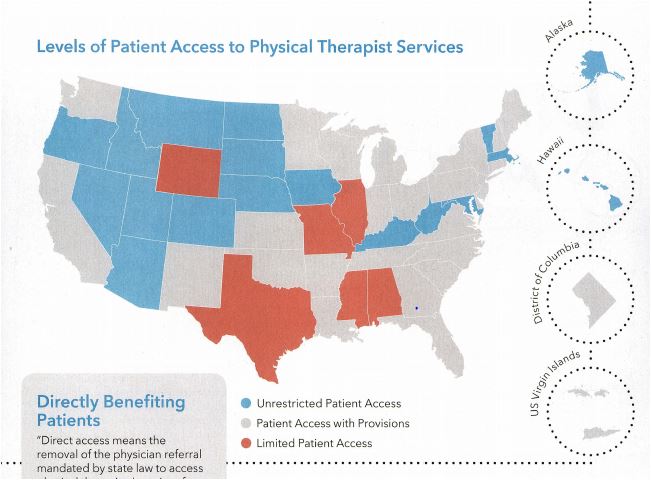
The multi-decade struggle to achieve direct access in every state and locality was all about celebrating successes, conveying momentum, and encouraging chapters’ efforts to fight access restrictions. Given fierce opposition from physician groups, chiropractors, and others, every win — however large or small — was considered important.
In some cases, the first step was getting a proverbial foot in the door via legislation seeking limited direct access. Thus, for example, when Texas PTs in 1991 won the right to evaluate patients without referral, and to treat them for conditions or injuries that had been the subject of a physical therapy referral within the previous year, the state was added to the “direct access” list. APTA and the Texas Physical Therapy Association were thrilled to tout a victory that in today’s context seems perhaps minor. In 1991, however, securing evaluation without referral was a huge landmark. In those days, when physician referral was the norm and patients in some states lacked direct access even to evaluation by a PT, there were no “levels” of direct access. As different jurisdictions passed laws and regulations that granted varying degrees of access, the terms “unrestricted access,” “patient access with provisions,” and “limited patient access,” became three main categories used to identify a state’s level of direct access to PT services.
Victories both big and small continued, with APTA supporting the chapters in their efforts and lauding their successes. The triumphs often fell far short of giving consumers unrestricted patient access to physical therapist services, and several chapters waged successful fights in the 2000s to further liberalize that access.
By the end of 2013, the Oklahoma and Michigan chapters were well-positioned to help achieve passage of legislation the following year to become the 49th and 50th states on the direct access list. That day came in 2015, and the achievement was recognized and hailed as the culmination of the thousands of PTs’ hard work on behalf of patients. However, APTA also recognized the fact that significant barriers to patient access remained in place in many states. In jurisdictions where “patient access with provisions” and “limited patient access” restrictions remain, efforts continue at both the chapter and national level to eliminate or ease them.